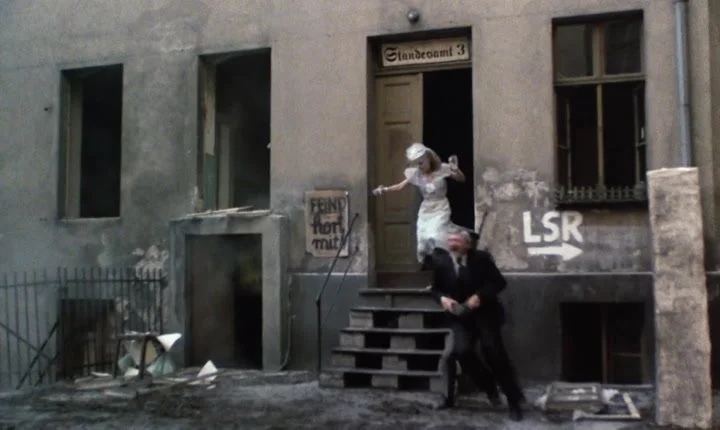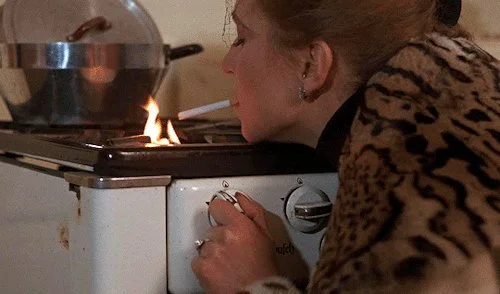Prosperity and Ruin: Maria’s Death as Allegory for attitudes towards post-war germany
Rainer Werner Fassbinder’s The Marriage of Maria Braun (1979) opens with a wedding and ends with a death—both scenes interrupted by explosions. The first, a bomb dropped amid Maria and Hermann’s rushed wartime ceremony, reflects the external chaos of a nation at war. The last, a gas explosion in a quiet domestic setting, stems from within: it occurs in Maria’s home, possibly triggered by a cigarette she lights in solitude. This structural symmetry—the first and last scenes joined by violent rupture—invites a political reading of Maria’s arc not merely as personal tragedy but as national allegory.
Maria and Hermann flee their wedding
Maria lights a cigarette on the stove
Maria lights the cigarette that will kill herself and Hermann
Maria’s death is neither a simple suicide nor a tragic accident, but a symbolic indictment of post-war Germany. Through Maria’s rise to power and her destruction by the very symbols of her success, Fassbinder suggests that the prosperity of the Federal Republic is built on unresolved trauma and moral compromise. Maria’s death represents the self-destruction of a nation blinded by economic triumph and historical amnesia.
The film’s opening wedding scene is emblematic of wartime absurdity. Maria and Hermann exchange vows amidst rubble, soldiers, and a collapsing state. The ceremony is interrupted by an air raid, scattering attendees and turning celebration into chaos. Violence here is external and arbitrary, the product of a national crisis beyond individual control. This opening sets the stage for the narrative’s concern with survival and reinvention: an exploration into how individuals, and by extension nations, rebuild after catastrophe.
The final scene mirrors this structure but alters its logic. The explosion that kills Maria occurs after the war, after Maria has seemingly triumphed over adversity. She has ascended socially and economically and has eventually reclaimed her autonomy through financial and emotional control. The explosion here is domestic, private—caused not by an enemy bomb but by an action Maria herself initiates. Whether she knowingly turns on the gas before lighting a cigarette or dies in an accidental blaze is ultimately secondary. The symbolic resonance remains: Maria is destroyed not by war, but by peace. She is destroyed not by scarcity, but by abundance.
Throughout The Marriage of Maria Braun, cigarettes serve as a recurring motif, closely tied to ideas of autonomy, class, and modern femininity. In the film’s early scenes, cigarettes are scarce and rationed—symbols of Western luxury and American abundance. Maria’s ability to obtain and smoke a cigarette becomes a marker of her agency. As she gains power, cigarettes become increasingly accessible, integrated into her persona as a modern, liberated woman. The fact that a cigarette appears to cause her death is no accident. Fassbinder repurposes this symbol of independence into an emblem of decay, suggesting that the very markers of success in post-war Germany (consumer goods, self-determination, capitalist mobility) are laced with danger. Maria’s cigarette, once a badge of survival, becomes an instrument of destruction.
This reversal speaks directly to Fassbinder’s broader critique of West Germany’s rapid economic recovery in the decades following World War II. For many, this prosperity signaled renewal. Fassbinder, however, viewed the sudeen affluence not as evidence of moral reckoning but as a form of evasion. In Maria’s arc — from trauma to triumph to total collapse — Fassbinder charts a path he believed the nation itself was taking: outward success masking inward rot.
The final montage reinforces this interpretation. After the explosion that kills Maria and Hermann, the film cuts to still images of West Germany’s post-war chancellors. Unlike Adolf Hitler, whose image is earlier destroyed onscreen in a symbolic purging of the past, these leaders remain intact. The implication is ominous. Though Nazism had technically been defeated, certain power structures lived on without rupture. Fassbinder’s camera does not explode them because the society they preside over has not yet reckoned with its origins. Maria’s death, positioned immediately before this sequence, becomes a national metaphor: a warning that beneath the surface of democratic capitalism lies a continuity of denial, suppression, and decay.
One could argue that Maria’s death is an act of suicide: a final rejection of a life built on compromise, manipulation, and emotional detachment. Certainly, the scene is ambiguous. Maria lights the gas in the kitchen, pours drinks, and prepares for what might be a reconciliation or a farewell with Hermann. But even this reading supports the allegorical interpretation. If Maria is taking her life, she is doing so at the peak of her apparent success. This act underscores the hollowness of that success. She has money, property, and independence, but no meaningful relationships or emotional fulfillment. Her transactional existence which is rooted in war, occupation, and opportunism has left her morally and spiritually bankrupt. Her suicide, then, is not just personal; it is emblematic of a broader collapse.
Hermann’s return complicates this dynamic further. Though he has remained emotionally distant throughout the film — first physically absent due to war, later willfully estranged —his reappearance just before Maria’s death seems to offer a chance at reconciliation. But this reunion, like so many moments in the film, happens too late. Their love, once framed as Maria’s guiding principle, has been eroded by time and self-interest. Fassbinder critiques not only the loss of romantic idealism but the futility of trying to restore it in a post-war world that has fundamentally changed.
Critics have long noted Fassbinder’s critical stance toward German memory culture. In his work, the post-war period is not a clean break from fascism but a continuation of its structural and psychological legacies under new names: capitalism, bureaucracy, and patriarchy. In this context, Maria’s death is not an isolated event but part of a larger system of repetition and self-deception. The war is over, but its consequences remain unresolved. The domestic sphere, meant to symbolize safety and rebirth, is shown to be just as unstable as the battlefield.
Additionally, Fassbinder’s choice of a female protagonist is significant. Maria is not simply a victim of circumstance but a complex agent of her own rise and fall. Her navigation of male power reveals both her strength and the limitations placed upon her. In Maria, Fassbinder constructs a character who embodies the contradictions of post-war femininity: liberated yet objectified, independent yet commodified. Her death marks the failure of the system to sustain the very modern woman it claims to empower.
In the end, The Marriage of Maria Braun presents a bleak but incisive vision of post-war Germany. Fassbinder does not celebrate the nation’s reconstruction; he mourns its inability to confront its past and its choice to equate material recovery with moral resolution. Maria’s death, brought about by the symbols of her supposed freedom, is a cautionary tale about the cost of forgetting. Through the allegory of her life and demise, Fassbinder warns that the nation, like Maria, may ultimately be destroyed not by the horrors of the past, but by its refusal to truly reckon with them.


